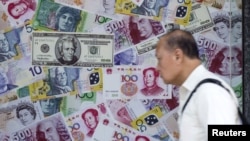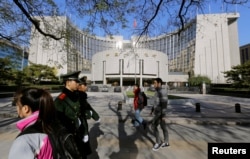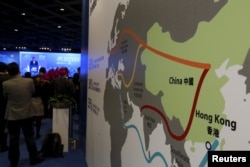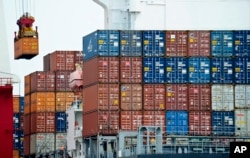With uncertainty over economic policy direction in the United States, Southeast Asian economies appear less reliant on U.S. monetary decisions, with analysts saying China's influence is likely to keep growing in the region.
On Thursday, a sign of the region's greater financial independence came as most regional markets failed to follow a .25 basis point rise in interests rates set by the U.S. Federal Reserve. But China, Hong Kong and Singapore did raise interest rates.
London based analysts at Capital Economics said for most emerging economies in Asia, local factors rather than the actions of the U.S. central bank will determine interest rate policy.
Beijing's growing influence has come as Asian economies have stepped up trade with China, whose growing presence was highlighted after the U.S. withdrawal earlier this year by U.S. President Donald Trump from the 12 nation Trans Pacific Partnership (TPP).
The TPP had been a key policy platform under former President Barack Obama's pivot to Asia to extend U.S. influence in the region.
Thai economist Somphob Manarangsan said China's One Belt One Road' policy to boost links with China's growing economy will increase the momentum of regional economic integration.
"From now on China may move more actively to this region [Southeast Asia]. China is the real sector based economy [of manufacturing] as you know, so they have to have greater integration of the supply chain and value chain, and it can replace the greater uncertainty of the U.S. market," Somphob told VOA.
Growing regional influence
As China's economy becomes more influential economically in the region, the country's social and political influence will also increase, he said.
Uncertainty over U.S. economic policy towards the Asia region, and especially in trade, followed election campaign comments by President Trump, to adopt a tougher stance on trade with China, accusing Beijing of acting as a "currency manipulator."
Somphob said protectionist U.S. economic policy would result in countries in Asia facing a "tough struggle" with any major fallout in bilateral relations with China having a significant impact across the region.
"It will be relatively serious. As we know that China is one of the major regional supply [chains]. So that means that directly or indirectly it's going to affect the ASEAN economy considerably," he said, with the impact also on Japan and South Korea.
Southeast Asia's trade ties with China have been growing over the past decade, especially intermediate goods to China that are then exported to major international markets, such as the U.S.
In a commentary, Asian Development Bank (ADB) senior economist, Cyn-Young Park, says the growth of emerging East Asian economies' has been "underpinned by dynamic growth in China."
Regional impact
A shift in the U.S. market's role has been evident as Southeast Asia's exports to the U.S. have fallen from 50 percent of total exports in the 1990s to around less than 29 percent today.
But Park also warned any global shock would have a major impact on the region's economies.
"Emerging East Asia has become more, not less, integrated with the global economy and as a result the impact of a global shock, whether related to trade or financial markets, has become greater," he said.
Pavida Pananond, a professor of business studies at Bangkok's Thammasat University, said steady economic growth over recent decades has strengthened economies due to a growing middle class.
"And that's why the shifting focus of the regional integration in Asia, or its regional focus, is not solely because of the Trump policies but it is the changing dynamics in the economic power that has been taking place over a few decades," Pavida said.
"The rising power of the consumer in Asia is becoming more important. China is growing. China is now the major trade and investment destination to and from ASEAN [Association of Southeast Asian Nations]," she said.
Protectionism gaining ground
The World Bank, in a report, warned the region's economies of "heightened policy uncertainty in advanced economies," especially Europe and the U.S. amid growing support for trade protection.
"Rising political opposition to trade has contributed to a post [2008] crisis high in new trade restrictions in the past year," the Bank said.
"The imposition of trade barriers by major trading partners would disproportionately affect the relatively more open economies of East Asia and Pacific," it said.
The bank added that a "faster than expected slowdown in China would have sizable regional spillovers."
But Capital Economics analysts say the U.S. administration appears less confrontational on the issue of trade relations with China than feared.
"The threat to label China a currency manipulator on [President Trump's] first day in office failed to materialize, talk of an across the broad tariffs have been dropped, while growing question marks over a proposed border-adjusted corporate tax," Capital Economics' Gareth Leather said.










